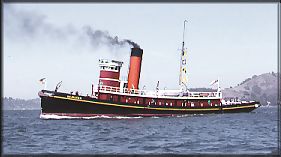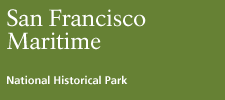hercules

| STATS |
|
| Overall length |
151 feet |
| Fuel type |
Bunker C |
| Beam |
26 feet |
| Draft |
18 feet aft, 10 feet forward |
| Gross tonnage |
409 |
| Engine |
3 cylinders, triple expansion |
| Cylinders |
17", 24", and 41" with 30" stroke. At 90rpm: 125psi/770hp (originally 180psi/1000hp) |
| Boiler |
Scotch marine fire tube. 16' diameter, 11’9" long. Four, oil-burning furnaces |
"Out
through the Golden Gate, the most beautiful harbor in the world. North,
towing this barkentine to Port Washington in Canada. Thence south,
empty, to Astoria where we picked up six million feet of timber in a
raft to tow south to San Diego. Long, slow, lazy days, making no more
than three knots. Even the patent log [a device trailed in the water to
measure speed] would not work. We rigged a fishing line on it and
caught beautiful king salmon on the way."
Albert J. Hody, fireman, describing life aboard Hercules in 1919. Excerpted from an oral history in the Park's collection.
Careers
Long Tows--Open Ocean
John H. Dialogue and Son, of Camden, New Jersey, built Hercules
in 1907. She had been ordered by the San Francisco-based Shipowners’
and Merchants’ Tugboat Company, to join their Red Stack fleet (named
for their red-painted smoke stacks). When completed, Hercules towed her sister ship, the Goliah, through the Strait of Magellan to San Francisco. Both vessels were oil-burners; Goliah carried fuel, water and supplies for her sister.
Hercules
towed barges, sailing ships and log rafts between Pacific ports.
Because prevailing north-west winds generally made travel up the coast
by sail both difficult and circuitous, tugs often towed large sailing
vessels to points north of San Francisco. In 1916, Hercules towed the C.A. Thayer
(another of San Francisco Maritime National Historical Park’s historic
fleet) to Port Townsend, Washington. The trip took six days. She also
towed the Falls of Clyde, now a museum ship in Hawaii.
On trips back down the coast, Hercules
often towed huge log rafts, laden with millions of board feet of
Northwest timber, to Southern California mills. At other times, Hercules
towed barges of bulk cargoes between other West Coast Ports, and to
Hawaii. During the construction of the Panama Canal, she towed a huge
floating caisson (a steel structure used for closing the entrance to
locks) to the Canal Zone.
In her deep-sea days, Hercules
usually carried a crew of fifteen-enough manpower for her Engine
Department to stand three watches while underway. The deep, narrow hull
made life uncomfortable at times, because it rode low in the water, and
the main deck was often awash. However, the food was good and, for an
experienced hand, the work was steady. Tugboat captains were generally
well-paid and highly respected, for it took considerable experience to
bring a tug and a heavy tow through high seas in bad weather--and good
judgement to navigate the shallow bars and narrow entrances of West
Coast ports.
Bay Tug Hercules
was eventually acquired by the Western Pacific Railroad Company. Her
career changed significantly; she no longer served as an ocean-going
tug, but shuttled railroad car barges back and forth across San
Francisco Bay. She worked until 1962, when changing transportation
patterns (the decline of the railroads) and the introduction of
diesel-powered tugs sealed her fate.
Restoration Hercules
avoided the scrap yard, but languished until the California State Park
Foundation acquired her for the San Francisco Maritime State Historic
Park, in 1975. The National Park Service took over the task of her
restoration in 1977, and in 1986 she was designated a National Historic
Landmark. Hercules has been documented as part of the Historic American Engineering Record's Maritime Project.
Today, after a thirty-year lay-up, she is operable again, and regularly steams the Bay with a highly-trained volunteer crew.
You Can Help
Volunteers played a major role in the Hercules
restoration. And they play a critical part in her continued
preservation. Contributions of materials and supplies from individuals,
groups and corporations aid the effort, but nothing takes the place of
hands-on dedication. If you are interested in joining this elite group
of weekend engineers and deck crew, contact the Park’s Volunteer Office at (415)556-1613. |



